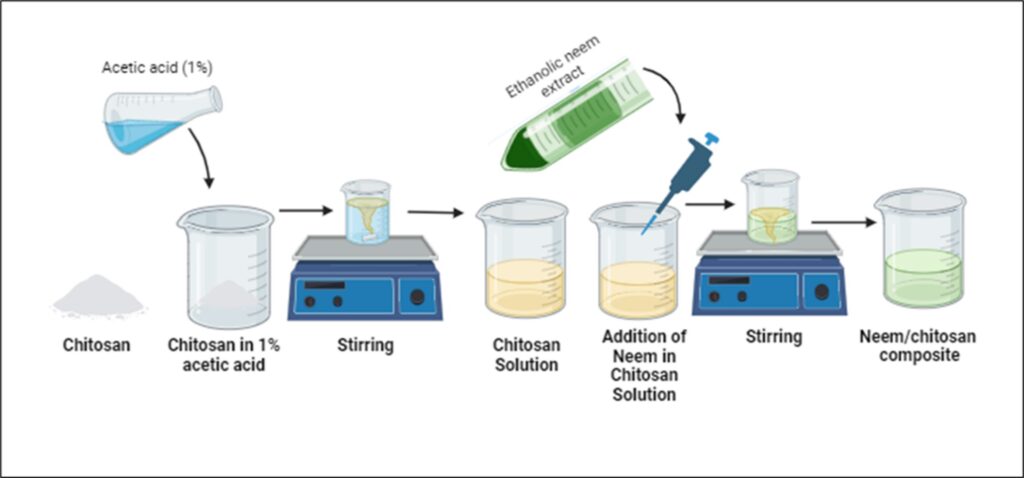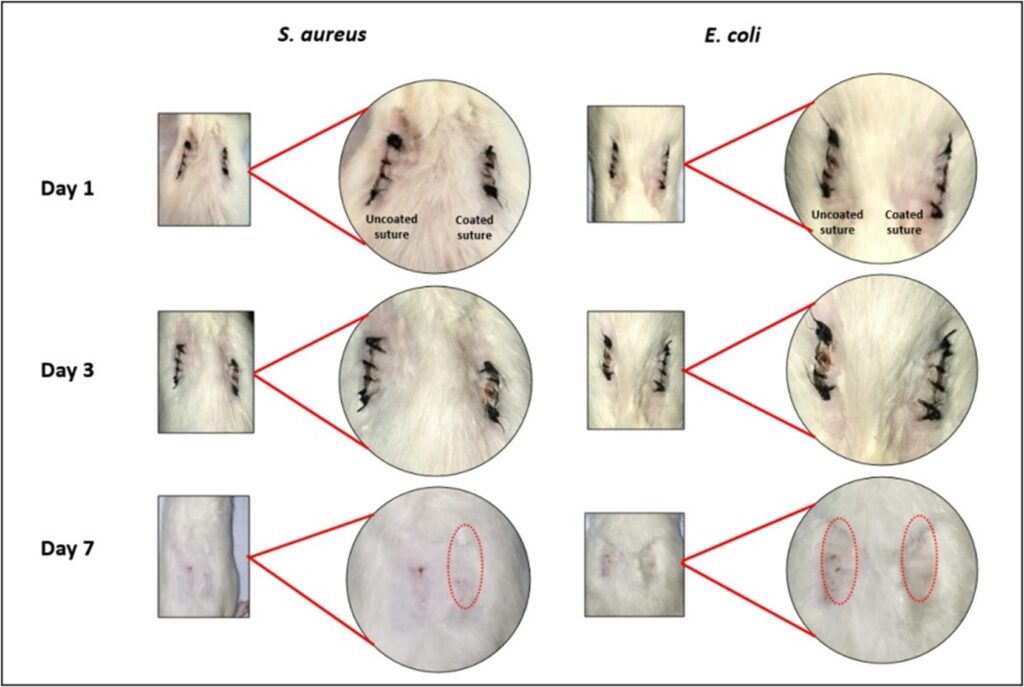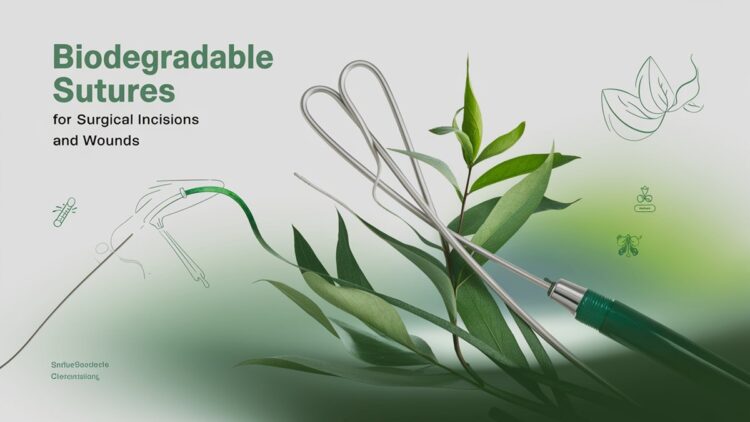
Introduction
Surgical site infections (SSIs) are among the most common hospital-acquired infections, posing significant risks to patient health and recovery. SSIs can lead to increased morbidity, prolonged hospital stays, and additional healthcare costs. Given these challenges, the development of antibacterial solutions to reduce the incidence of SSIs is crucial.

Project scope
- Coating on the suture with natural polymer and suitable drug with the help of a dip coating machine results in the control rate of inflammation.
- The coated sutures have effects such as reducing surgical site infections, accelerating wound healing, and reducing other post-operative complications.
- Reduce the need for supplemental drugs due to the presence of a suitable drug within the coating materials.
- The coated sutures have effects such as reducing surgical site infections, accelerating wound healing, and reducing other post-operative complications.

Teammates
Researchers from the School of Chemical and Materials Engineering, National University of Sciences and Technology (NUST), Pakistan, have undertaken a study aimed at developing and evaluating antibacterial-coated sutures to minimize the risk of SSIs. The team employed natural herbal extract techniques to coat sutures and conducted tests to observe the impact of these coatings on various bacterial strains. Their research holds substantial implications for both in vitro and in vivo detection of SSIs, offering innovative approaches to combat hospital-acquired infections.
The study was supervised by Dr. Muhammad Shoaib Butt from NUST, with contributions from Dr. Rumeza Hanif, an associate professor at the same institution, and master’s students Urwah Rasheed and Muhammad Naeem. Additionally, Hina Saeed from the Lahore College of Pharmaceutical Science, Lahore, collaborated on the project. Through their combined efforts, this research addresses an urgent need for improved surgical materials that can prevent infections and improve patient outcomes.

Type of problems the developed product solves
The antibacterial-coated sutures developed in this study tackle a critical healthcare issue: surgical site infections (SSIs). These infections are a leading cause of patient complications, prolonged hospital stays, and increased healthcare costs. Unlike traditional sutures, which can inadvertently promote bacterial growth, our coated sutures actively prevent infection at the wound site, creating a safer healing environment. This innovative approach offers a targeted solution to reduce SSIs, promising better patient outcomes and helping healthcare facilities lower infection-related burdens.

Preparation of coating material
The research team utilized various herbal extraction techniques and antibacterial testing methods to develop and evaluate antibacterial-coated sutures. They focused on the impact of these coatings on different bacterial strains commonly associated with surgical site infections. By employing advanced in vitro and in vivo assays, they examined how the antibacterial coatings affect bacterial growth, adhesion, and resistance. These tests allowed the researchers to observe the changes in infection prevention capabilities and antibacterial efficacy provided by the coated sutures, offering a promising solution to reduce the risk of hospital-acquired surgical site infections.
Key Features of the Antibacterial-Coated Sutures
- Antibacterial Properties: Coated with natural herbal extracts that inhibit bacterial growth, reducing the risk of surgical site infections.
- Enhanced Biocompatibility: Designed to be compatible with human tissue, promoting healing without adverse reactions.
- Broad-Spectrum Efficacy: Effective against multiple strains of bacteria commonly associated with hospital-acquired infections.
- Sustained Antibacterial Action: The herbal coating provides prolonged antibacterial effects, safeguarding the wound throughout the healing process.
- Environmentally Friendly: Uses natural extracts, making the product safer for the environment and reducing chemical waste in medical settings.
- Potential for Multifunctional Integration: Can be adapted to include additional properties, such as drug release or infection-detecting sensors, for future surgical applications.

Vivo Study
Building on the promising in vitro results of this study, ongoing in-vivo testing is currently being conducted to further evaluate the effectiveness of the antibacterial-coated sutures in real-world clinical environments. These tests aim to assess the sutures’ performance in reducing surgical site infections across a variety of surgical conditions and tissue types. The outcomes of these ongoing studies will provide valuable insights into the long-term efficacy, safety, and tissue compatibility of coated sutures.

Future application of the product
Future applications of these antibacterial-coated sutures extend beyond infection prevention in standard surgeries. With further development, they could be adapted for use in high-risk surgeries, such as orthopedic and cardiovascular procedures, where infection risks are particularly severe. Additionally, by integrating drug-release capabilities or infection-sensing technologies, these sutures could evolve into multifunctional tools, delivering antibiotics or alerting healthcare providers to early signs of infection directly at the wound site. This would create a new generation of “smart” surgical materials, improving patient outcomes, reducing the need for post-operative interventions, and helping hospitals better manage infection control.
Business potential of the product
The antibacterial-coated sutures hold immense business potential in the global medical device market, targeting the high demand for infection-prevention solutions. As hospitals seek effective ways to reduce surgical site infections, these sutures offer a natural, biodegradable alternative that enhances patient safety and lowers healthcare costs. With appeal across both advanced and developing healthcare markets, this innovative product could set a new standard in surgical care, making it an attractive investment for medical device companies and healthcare providers alike. The surgical suture market is growing rapidly. The market survey link is added for your reference and understanding. https://www.linkedin.com/pulse/2030-surgical-sutures-market-size-trends-growth-analysis-verma-gzwrc

Conclusion
In this study, we have successfully developed antibacterial-coated sutures using natural herbal extracts and demonstrated their effectiveness in reducing the risk of surgical site infections. Both in vitro and ongoing in vivo testing have shown promising results, with the coated sutures exhibiting significant antibacterial activity against various strains commonly responsible for hospital-acquired infections. The in-vitro tests confirmed the sutures’ ability to inhibit bacterial growth, while initial in vivo experiments indicate their potential for real-world application in preventing infections during and after surgical procedures.
These findings lay a strong foundation for further research, including large-scale clinical trials and optimization of coating formulations. The antibacterial-coated sutures have the potential to significantly improve patient outcomes by reducing infection rates and promoting safer surgical practices. Continued research and testing will be vital in refining this technology for broader clinical use, enhancing the safety and efficacy of surgical interventions.
Acknowledgments
This work was supported by the Pakistan Science Foundation (PSF) G-5/2, Islamabad-Pakistan under PSF grant.
References
- Rasheed, U., Kiani, M. N., Butt, M. S., Saeed, H., Hanif, R., & Anwar, S. (2024). Fabrication and biocompatibility of neem/chitosan coated silk sutures for infection control and wound healing. Journal of King Saud University-Science, 36(10), 103435. DOI: https://doi.org/10.1016/j.jksus.2024.103435
- Butt, M. S., Malik, Z., Ghaffar, R., Baluch, A. H., Saleem, M., & Ghaffar, A. (2024). Moringa oleifera/chitosan-coated silk sutures for improved wound healing. Materials Chemistry and Physics, 313, 128737. DOI: https://doi.org/10.1016/j.matchemphys.2023.128737
The author is an Tenured Associate Professor, at Department of Materials Engineering, School of Chemical and Materials Engineering (SCME), National University of Sciences and Technology (NUST). He can be reached at muhammad.shoaib@scme.nust.edu.pk.
Research Profile: https://bit.ly/4efaEMh

![]()




